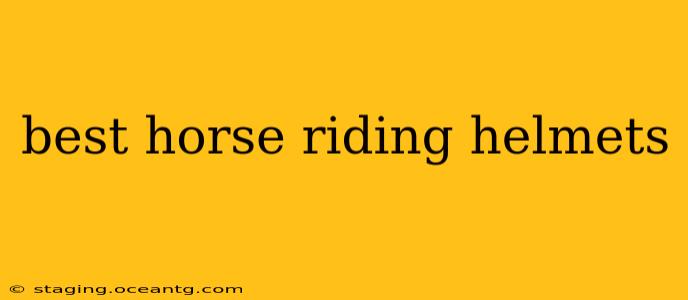Choosing the right horse riding helmet is crucial for your safety. A good helmet isn't just a piece of equipment; it's your first line of defense against head injuries. This comprehensive guide will delve into the key factors to consider when selecting a horse riding helmet, explore some of the top brands and models, and answer frequently asked questions to help you make an informed decision.
What to Look for in a Horse Riding Helmet
Several factors contribute to a helmet's effectiveness and comfort. Before diving into specific brands, let's explore the essential features:
-
Safety Standards: Ensure the helmet meets recognized safety standards such as ASTM F1163 (American Society for Testing and Materials) or PAS 015 (British Standard). These standards ensure the helmet has undergone rigorous testing to protect against impacts. Look for the certification mark clearly displayed on the helmet.
-
Fit: A properly fitting helmet is paramount. It should sit level on your head, approximately one to two finger-widths above your eyebrows. It shouldn't wobble or move around when you shake your head. Different brands offer various sizing systems, so consult their sizing charts carefully.
-
Comfort: A comfortable helmet will encourage you to wear it consistently. Look for features like adjustable straps, breathable liners, and a comfortable padding system. Discomfort can lead to riders removing their helmets, negating the safety benefits.
-
Weight and Ventilation: While safety is paramount, a lightweight helmet with adequate ventilation will enhance comfort, especially during longer rides. Overheating can be as distracting as discomfort.
-
Harness System: The harness should be securely fastened and adjustable to ensure a snug and customized fit. A well-designed harness will distribute impact forces effectively.
What are the different types of horse riding helmets?
Horse riding helmets are broadly categorized into several types, based on their design and intended use:
-
Standard/Traditional Helmets: These are the most common type, offering a good balance of safety, comfort, and affordability. They are suitable for most riders and riding disciplines.
-
Riding Hats with Peak/Brim: Some helmets include a peak or brim to provide shade from the sun. However, a large brim might interfere with your vision or get caught on obstacles, so consider this carefully.
-
Eventing Helmets: Specifically designed for eventing, these often incorporate more advanced features to withstand the higher risks associated with this discipline.
-
Children's Helmets: Designed with smaller heads and growing children in mind, these typically feature adjustable straps and lighter weight.
-
Specialized Helmets: Certain brands offer helmets designed for specific needs like improved ventilation or impact absorption characteristics.
How often should I replace my horse riding helmet?
Helmets are designed to absorb impact. Even if there’s no visible damage, the protective materials degrade over time and with repeated use. It's recommended to replace your helmet every 3-5 years, regardless of whether it has been involved in an accident. If your helmet has been involved in a fall, even a minor one, it should be replaced immediately.
What are some of the best horse riding helmet brands?
Many reputable brands produce high-quality horse riding helmets. Researching specific models within these brands is key to finding the perfect fit and features for your needs. Some well-known brands include but are not limited to: Charles Owen, GPA, Samshield, Tipperary, and One K.
How much should I expect to pay for a good horse riding helmet?
The price of horse riding helmets varies greatly depending on the brand, features, and materials used. You can expect to find helmets ranging from budget-friendly options to higher-end models with advanced features and technology.
Which helmet is best for a child?
Choosing a child's riding helmet requires particular attention to fit. Look for a helmet specifically designed for children, with adjustable features and lightweight construction. Prioritize helmets that meet appropriate safety standards, and ensure a proper fit before purchase. Regularly check the fit as your child grows.
Can I wear a bicycle helmet for horse riding?
No, bicycle helmets are not designed to withstand the specific impact forces involved in horse riding falls. They lack the necessary protection and certification for equestrian activities. Always wear a helmet specifically designed for horse riding.
This guide provides a starting point for your helmet selection journey. Remember, prioritize safety and fit when making your decision. A properly fitted helmet is your best defense against injury. Consult with professionals at your local equestrian store for personalized advice.
